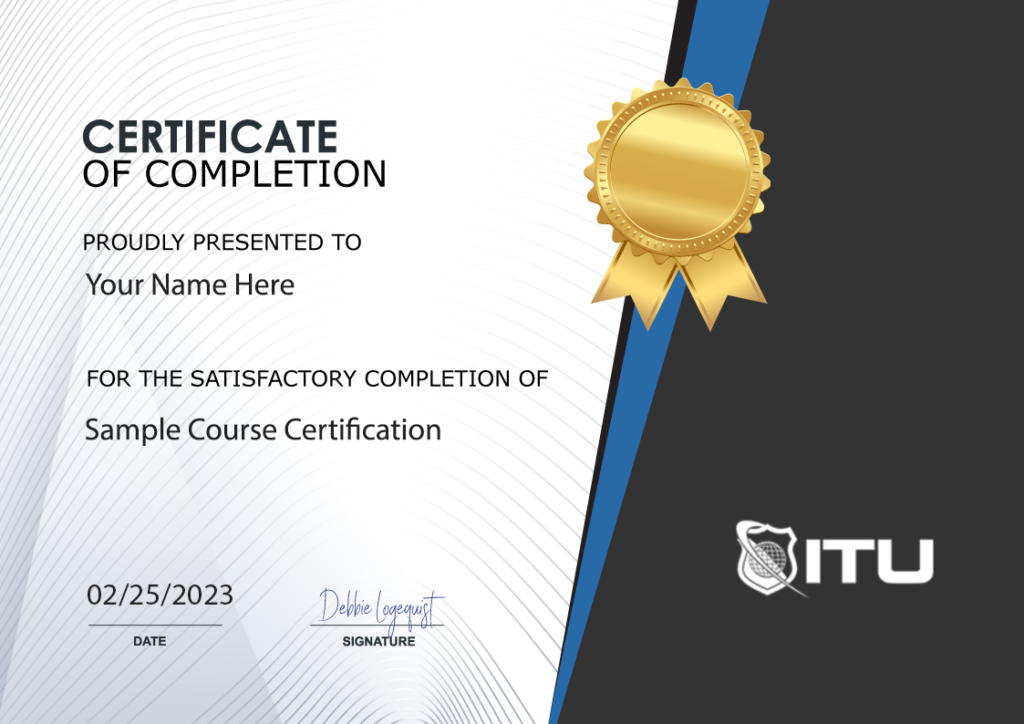Six Sigma Green Belt
In this Six Sigma Green Belt online program, Green Belt students will gain a comprehensive understanding of how to assess process components and analyze stakeholders in an organization. Furthermore, they’ll learn innovative concepts and tools for gathering customer information as well as their feedback. Ultimately, the primary goal is to equip learners with the skills needed to successfully identify and lead Lean Six Sigma projects using DMAIC problem-solving strategy.
Included In This Course



Closed Captions



Certificate of Completion
Course Description for Green Six Sigma Belt Certification
The Green Six Sigma Belt Certification course offers an in-depth understanding of Six Sigma principles and methodologies. This course is designed to equip participants with the skills to improve processes, enhance quality, and drive organizational success. Through a combination of theoretical knowledge and practical applications, you will learn to identify, analyze, and solve quality issues using Six Sigma tools and techniques.
Key concepts covered in this course include Lean principles, Design for Six Sigma, project identification and management, voice of the customer, process analysis and documentation, statistical distributions, hypothesis testing, and root cause analysis. By the end of this course, you will be well-prepared to contribute to Six Sigma projects and drive continuous improvement within your organization.
What You Will Learn in the Green Six Sigma Belt Certification Course
This comprehensive course will provide you with the essential skills and knowledge needed to effectively apply Six Sigma methodologies within your organization. You will gain hands-on experience with tools and techniques used by Six Sigma professionals to improve processes and achieve measurable results.
- Understanding Six Sigma and organizational goals
- Implementing Lean principles in your organization
- Applying Design for Six Sigma (DFSS)
- Identifying and managing Six Sigma projects
- Analyzing the voice of the customer
- Utilizing management and planning tools
- Conducting process analysis and documentation
- Applying probability and statistics
- Conducting hypothesis testing
- Performing root cause analysis
Exam Objectives for Green Six Sigma Belt Certification
The Green Six Sigma Belt Certification exam is designed to validate your understanding and application of Six Sigma principles. This certification is governed by the International Association for Six Sigma Certification (IASSC).
- Define Phase: Understanding organizational goals and project identification (15%)
- Measure Phase: Process analysis, probability, and statistics (20%)
- Analyze Phase: Data analysis, hypothesis testing, and process drivers (30%)
- Improve Phase: Design of experiments, root cause analysis, and lean tools (25%)
- Control Phase: Statistical process control and lean tools for process control (10%)
Who This Green Six Sigma Belt Certification Course is For
This course is ideal for professionals looking to improve their process improvement skills and advance their careers in quality management. It is suitable for individuals across various industries who are involved in or wish to be involved in Six Sigma projects.
- Quality control professionals
- Process improvement specialists
- Operations managers
- Project managers
- Business analysts
- Engineers
Possible Jobs You Can Get With Green Six Sigma Belt Certification
Achieving a Green Six Sigma Belt Certification can open doors to a variety of career opportunities in quality and process improvement. The skills and knowledge gained from this course are highly valued across many industries.
- Quality Assurance Manager
- Process Improvement Consultant
- Operational Excellence Manager
- Lean Six Sigma Specialist
- Project Manager
- Business Analyst
Average Industry Salaries for People with Green Six Sigma Belt Certification
Professionals with a Green Six Sigma Belt Certification are in high demand and can command competitive salaries. Here are some average salary ranges for roles that typically require this certification:
- Quality Assurance Manager: $80,000 – $110,000 per year
- Process Improvement Consultant: $75,000 – $105,000 per year
- Operational Excellence Manager: $85,000 – $115,000 per year
- Lean Six Sigma Specialist: $70,000 – $100,000 per year
- Project Manager: $80,000 – $120,000 per year
- Business Analyst: $70,000 – $95,000 per year
Get Started Today with Green Six Sigma Belt Certification
Take the first step towards enhancing your career and improving your organization’s processes. Enroll in the Green Six Sigma Belt Certification course today and gain the skills you need to become a leader in quality management. With our expert instructors and comprehensive course materials, you’ll be well-prepared to achieve certification and make a significant impact in your field.
Don’t miss this opportunity
Six Sigma Black Belt – Becoming a Black Belt indicates your expertise in the Six Sigma philosophy and principles. As such, you become an influential driving force of change within any organization while leading project teams to success. If you are determined to achieve the rank of Black Belt, look no further than our Black Belt Six Sigma online program
Key Term Knowledge Base: Key Terms Related to Six Sigma Green Belt
The Six Sigma Green Belt course from ITU Online focuses on the DMAIC approach and Six Sigma methodologies. Below is a list of key terms that are essential for this training:
| Term | Definition |
|---|---|
| Six Sigma | A set of techniques and tools for process improvement aimed at improving quality and efficiency. |
| Green Belt | A level within the Six Sigma certification structure, focused on data analysis and project leadership. |
| DMAIC | An acronym for Define, Measure, Analyze, Improve, Control – a process improvement method in Six Sigma. |
| Process Improvement | A strategic approach to optimizing processes to increase efficiency and quality. |
| Statistical Analysis | The process of collecting, analyzing, interpreting, and presenting data. |
| Lean Six Sigma | A methodology that combines the waste reduction principles of Lean with the process improvement tools of Six Sigma. |
| Root Cause Analysis | A method of problem-solving that aims to identify the root causes of faults or problems. |
| Control Charts | Tools used in Six Sigma to monitor process stability and control. |
| Process Capability | A statistical measure of a process’s ability to produce output within specification limits. |
| Value Stream Mapping | A Lean tool used to visualize the steps needed to take from product creation to delivering it to the end-customer. |
| Kaizen | A Japanese term meaning ‘continuous improvement’, used in the context of business processes. |
| Pareto Chart | A graphical tool used in Six Sigma for prioritizing potential causes of a problem. |
| SIPOC | An acronym for Suppliers, Inputs, Process, Outputs, Customers – used in process mapping. |
| 5S | A workplace organization method that describes how to organize a workspace for efficiency and effectiveness. |
| Muda | A Japanese term for ‘waste’, used in Lean and Six Sigma to refer to non-value-added activities. |
| Gemba | The Japanese term for ‘the real place’, in business it refers to the place where value is created. |
| PDCA Cycle | Plan-Do-Check-Act, a four-step management method used for control and continuous improvement of processes. |
| Black Belt | A higher level of Six Sigma certification, focusing on project leadership and more complex analyses. |
| Benchmarking | The practice of comparing business processes and performance metrics to industry bests and best practices. |
| Variation Reduction | In Six Sigma, the process of reducing variability in manufacturing and business processes. |
These terms provide an essential foundation for understanding Six Sigma principles and methodologies, particularly for those pursuing the Green Belt certification.
Frequently Asked Questions About Six Sigma Online Training
What is Six Sigma?
Six Sigma is a disciplined and data-driven methodology aimed at improving business processes and reducing defects or errors in a systematic way. It focuses on achieving near-perfect performance by minimizing process variations.
What is a Six Sigma Green Belt?
A Six Sigma Green Belt is an individual who has been trained in the Six Sigma methodology and tools. Green Belts work on Six Sigma projects under the guidance of Black Belts and assist in process improvement initiatives within their organizations.
What are the benefits of Six Sigma Green Belt training?
Six Sigma Green Belt training equips individuals with the knowledge and skills to identify process improvement opportunities, collect and analyze data, and implement solutions. It helps organizations reduce defects, increase customer satisfaction, improve efficiency, and achieve cost savings.
Who should attend Six Sigma Green Belt training?
Six Sigma Green Belt training is ideal for professionals who want to enhance their problem-solving abilities and contribute to process improvement efforts. It is suitable for project managers, team leaders, quality professionals, engineers, and individuals responsible for process optimization.
How long does Six Sigma Green Belt training typically last?
The duration of Six Sigma Green Belt training can vary depending on the training provider and the specific program. Typically, it ranges from a few days to a few weeks, with a combination of classroom or online sessions, case studies, and practical exercises.
What topics are covered in Six Sigma Green Belt training?
Six Sigma Green Belt training covers various topics, including the DMAIC (Define, Measure, Analyze, Improve, Control) methodology, process mapping, data collection and analysis, statistical tools, root cause analysis, hypothesis testing, process capability, and project management.
Is there a certification for Six Sigma Green Belt?
Yes, there are several certification bodies that offer Six Sigma Green Belt certifications. These certifications validate an individual’s knowledge and expertise in Six Sigma methodologies and tools. Examples include the ASQ (American Society for Quality) Green Belt certification and the IASSC (International Association for Six Sigma Certification) Green Belt certification.
Can I implement Six Sigma concepts after Green Belt training?
Yes, Six Sigma Green Belts are trained to apply Six Sigma tools and techniques to real-world projects. They can lead and support improvement initiatives, analyze data, identify root causes, and implement solutions. However, the extent of their authority and scope may vary depending on the organization and its structure.
Can I pursue Six Sigma Black Belt training after Green Belt?
Yes, many individuals choose to further their Six Sigma knowledge by pursuing Six Sigma Black Belt training. Black Belt training delves deeper into advanced statistical analysis, project management, and leadership skills. It enables individuals to lead larger improvement projects and mentor Green Belts.
How can Six Sigma Green Belt training benefit my career?
Six Sigma Green Belt training enhances your problem-solving abilities, analytical skills, and process improvement expertise. It can make you a valuable asset to organizations seeking to optimize their processes. Green Belt certification can boost your resume and open up new career opportunities in quality management, operations, project management, and more.
Proudly DisplayYour Achievement
Upon completion of your training, you’ll receive a personalized certificate of completion to help validate to others your new skills.
Six Sigma Green Belt Course Content
Module 1: Six Sigma And The Organization
- Introduction
- Six Sigma And The Organization Goals-Part 1
- Six Sigma And The Organization Goals-Part 2
- Lean Principles In The Organization
- Design For Six Sigma
Module 2: Define PhaseProject Identification
- Define Phase-Project Identification-Part 1
- Define Phase-Project Identification-Part 2
- Define Phase-Project Identification-Part 3
Module 3: Define PhaseVoice Of The Customer
- Define Phase-Voice Of The Customer-Part 1
- Define Phase-Voice Of The Customer-Part 2
Module 4: Define Phase Project Management Basics on Six Sigma Green Belt
- Define Phase-Project Management Basics-Part 1
- Define Phase-Project Management Basics-Part 2
Module 5: Define PhaseManagement And Planning Tools
- Define Phase-Management And Planning Tools-Part 1
- Define Phase-Management And Planning Tools-Part 2
Module 6: Define PhaseBusiness Results For Projects
- Define Phase-Business Results For Projects-Part 1
- Define Phase-Business Results For Projects-Part 2
Module 7: Define PhaseTeam Dynamics And Define Phase Summary Review Questions
- Define Phase-Team Dynamics And Review Questions
- Define Phase-Summary And Review Questions
Module 8: Measure PhaseProcess Analysis And Documentation
- Measure Phase-Process Analysis And Documentation
Module 9: Measure PhaseProbability And Statistics
- Measure Phase-Probability And Statistics
Module 10: Measure PhaseStatistical Distributions
- Measure Phase-Statistical Distributions
Module 11: Measure PhaseCollecting And Summarizing Data
- Measure Phase-Collecting And Summarizing Data-Part 1
- Measure Phase-Collecting And Summarizing Data-Part 2
Module 12: Measure PhaseMeasurements System Analysis (MSA)
- Measure Phase-Measurements System Analysis(MSA)
Module 13: Measure PhaseProcess And Performance Capability And Measure Phase Summary And Review
- Measure Phase-Process And Performance Capability And Measure Phase Summary And Review
Module 14: Analyze PhaseExploratory Data Analysis And Hypothesis Testing
- Analyze Phase-Exploratory Data Analysis And Hypothesis Testing-Part1
- Analyze Phase-Exploratory Data Analysis And Hypothesis Testing-Part2
- Analyze Phase-Exploratory Data Analysis And Hypothesis Testing-Part3
Module 15: Analyze Phase Process Drivers
- Analyze Phase-Process Drivers-Part 1
- Analyze Phase-Process Drivers-Part 2
- Analyze Phase-Process Drivers-Part 3
- Analyze Phase-Process Drivers-Part 4
- Analyze Phase-Process Drivers-Part 5
Module 16: Improve PhaseDesign Of Experiment (DOE)
- Improve Phase-Design Of Experiment(DOE)-Part 1
- Improve Phase-Design Of Experiment(DOE)-Part 2
Module 17: Improve PhaseRoot Cause Analysis
- Improve Phase-Root Cause Analysis-Part 1
- Improve Phase-Root Cause Analysis-Part 2
- Improve Phase-Root Cause Analysis-Demo
Module 18: Improve PhaseLean Tools
- Improve Phase-Lean Tools-Part 1
- Improve Phase-Lean Tools-Part 2
- Improve Phase-Lean Tools-Part 3
- Improve Phase-Lean Tools-Part 4
Module 19: Control Phase Statistical Process Control
- Control Phase-Statistical Process Control
Module 20: Control PhaseLean Tools For Process Control
- Control Phase-Lean Tools For Process Control-Part 1
- Control Phase-Lean Tools For Process Control-Part 2
- Control Phase-Lean Tools For Process Control-Part 3
Module 21: Review ExamPrep And Key Concepts
- Exam Review And Key Concepts-Part 1
- Exam Review And Key Concepts-Part 2
- Exam Review And Key Concepts-Part 3
- Exam Review And Key Concepts-Part 4
- Exam Review And Key Concepts-Part 5
- Exam Review And Key Concepts-Part 6
- Exam Review And Key Concepts-Part 7
- Exam Review-Flash Cards
- Conclusion
| 5 star | 82 | 82% |
| 4 star | 17 | 17% |
| 3 star | 1 | 1% |
| 2 star | 0% | |
| 1 star | 0% |
Sorry, no reviews match your current selections

Subscribe To All-Access
Lock In $16.99 / Month Forever
Access this course and over 3,000 hours of focused IT training. Start your first month for only $1.00. Then lock in only $16.99 / month for life.
- Get Every Course
- Free Updates / New Content Added
- 3,000+ Hours of Training
- Price Lock Guarantee
- Games / Flashcards
- 21,000+ Practice Questions
$49.99 $16.99 Monthly
$49.00




good
Smooth delivery and easy access to LMS. Good to see that the LMS offers progress tracking. Would be great if badges were offered on completion of courses to share via Credly to future employers.